MEKONG AND TONLE SAP RIVERS
We were cautioned that crossing the border in to Cambodia was a slow bureaucratic process, and it was. It took about four hours. During that time, we were in our cabin napping when we were startled awake by a loud rapping on our door. It was an unfriendly Cambodian immigration officer scolding Bud for leaving a box unchecked on his immigration form – the box asking if we had more than $7,000 cash with us. Bud answered the question and apologized for the oversight, and the grumpy bureaucrat left to harass other passengers.
Then the skies opened and it started pouring rain. It rained for hours, and we interpreted this as an excuse to sleep a few more hours. We got up for a shower and dinner, then we went back to sleep some more.
In the meantime, the ship and all its passengers had cleared customs and immigration, and we were underway again. We would proceed up the Mekong River to near Phnom Penh – sixty miles north of the border.
Phnom Penh is the capital of Cambodia with a population of 1 million. It is located near where the Mekong, Tonle Sap, and Bassac Rivers converge. Its French colonial history is evident in its ageing architecture which gives the city a certain charm. There are countless cafes and bars. It is a relatively small city, but a city nonetheless, where one can find any product or service available in larger cities. It is a city in which we would have liked to spent more time than we did.
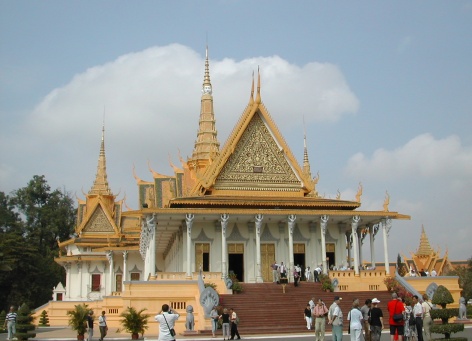
The Throne Hall at the Royal Palace
Our first stop in Phnom Penh was the Royal Palace. The Royal Palace is the principal residence of the king, queen, and royal family. From the Angkor period forward, there have been many palaces as the capital city moved; however, this palace was built in 1866, and the monarchy has lived here since (except, of course, during during King Sihanouk’s exile).
The palace compound is more than 45 acres, and there are countless ornate buildings scattered about. The buildings are typical Khmer architecture with many-tiered tiled roofs topped by gilded towers. They are painted yellow and white – yellow represents Buddhism and white represents Brahmanism.
We were able to visit the throne hall which is a magnificent building built in 1917. It is 200 feet long by 100 feet wide and 200 feet tall. It is highly ornate and rich in symbolism. Unfortunately, it is very rarely used.
We also visited the Silver Pagoda so called because the floor is covered with 5,000 silver tiles weighing five tons. Although the floor is nice, the contents of the pagoda are even more impressive. There is one 17th century Buddha statue made of emeralds and Baccarat crystals. Another Buddha statue contains 200 pounds of pure gold and more than 2,000 diamonds with one diamond exceeding 25 carets in size. Amazing.
And our final stop within the compound was the Preah Sihamoni’s Expo. This is a model of the coronation procession of the current king – His Majesty King Norodom Sihamoni. This procession is depicted with human models each about 18 inches tall. We actually found this a bit tacky after having just visited the big gold Buddha, but it was informative.
The National Museum houses the world’s finest collection of classical Angkor period sculpture. Unfortunately, this collection was seriously looted during the Khmer Rouge years. However, it still has a collection representing all of the empires. Photos are not allowed inside the museum.
We browsed through a local market in Phnom Penh. This always seems a worthwhile venture in glimpsing in to local life. Although this market was bigger than others we had recently visited, it was not qualitatively different. Just more of the same things.
These buildings were previously the Ponhea Yat High School then the Tuol Svay Prey High School. They were taken over by the Khmer Rouge security forces in the mid-1970s and converted in to a prison – Security Prison 21 or S-21. Although there were approximately 45 Khmer Rouge prisons in Cambodia, S-21 was the most infamous and brutal.
All classrooms were converted in to prison cells. Single prisoner cells measured 2 ½ by 6 ½ feet. Multi-prisoner cells measured 26 by 20 feet. Windows were barred and covered with barb wire. Prisoners were shackled with chain to the floor or wall. The torture that occurred there is shocking.
In 1975, records indicate that only 154 prisoners were brought to S-21. That number increased steadily, and only three years later, 5,765 prisoners were brought there. In all, more than 17,000 passed through S-21, and these numbers do not include the children whose numbers have been estimated at 2,000.
At the height of activity at S-21, 100 persons were killed every day. Only six people are known to have survived S-21.
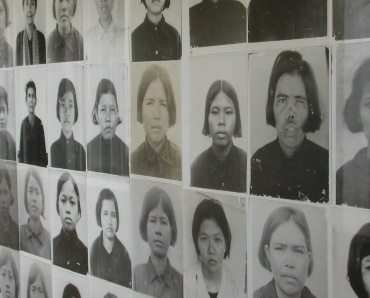
Most of the prisoners at S-21 were photographed there are thousands of these photos
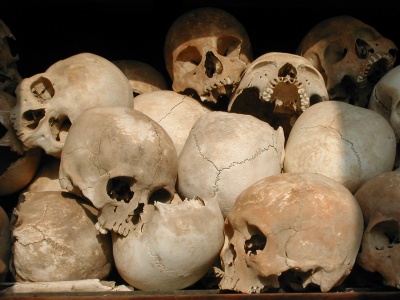
The fate of 2 million Cambodians
Prisoners that survived the conditions and torture at S-21 were brought to Choeung Ek to be executed. Most were dumped in mass graves. Many of those graves have been excavated, and the findings were horrific.
In remembrance of those persons, a large stupa has been built that houses 8,000 skulls. Some skulls have bullet holes. Others have caved in areas. To save bullets, many were killed by blunt force.
However, a walk around the fields is more disturbing. There are large holes in the ground where mass graves were excavated. There are occasional pieces of bone or teeth. But most disturbing are the clothes. Wherever one walks, it is nearly impossible to avoid stepping on clothing that continues to find its way to the surface. It gives some indication of the number of bodies still just below the surface. However, the government has decided that they will not excavate any further. Those bodies will remain where they are.
It was difficult to feel good about mankind as we made our way back to the boat knowing that Choeung Ek is just one of many killing fields in Cambodia. It is, however, believed to be the largest.
The Mekong River splits just north of Phnom Penh. To the northwest is the Tonle Sap River. The Mekong River continues to the east then even a bit southeast. The next day we made our way another 64 miles up the Mekong to the east then southeast to Kampong Cham. We made two stops along the way.
Our first stop was at Chong Koh village. This is a small silk weaving village where every house has a loom under it. The women were selling scarves and krama, and they were a bit too assertive. Although we saw some beautiful fabrics there, we didn’t like the hard sell tactics. We did, however, enjoy the horse-drawn carts throughout the village. We saw only bicycles, motor scooters, and carts – no cars.
Our next stop was at Angkor Ban Village. This impressed us as a very local village. We saw people seemingly going about their daily lives. We caught many people bathing, we saw feed corn and chiles drying, we came upon a cock fight, and we roamed through their very small market. They too, like Chong Koh Village, use horse carts. Unfortunately, Angkor Ban Village was exceptionally dry and dusty. Any activity would create a minor dust storm, and that cannot be healthy to breathe regularly. We wondered if this was common throughout the dry period.
We asked our guide about the authenticity of the villages we were visiting, and he said that he would give Chong Koh a score of only 60%, but he would give Angkor Ban Village a score of 80%. This was close to how rural Cambodian villagers live when removed from the influence of tourism. Some of our fellow passengers found this a bit boring, but it is exactly what we seek out when we are sailing. We really liked it.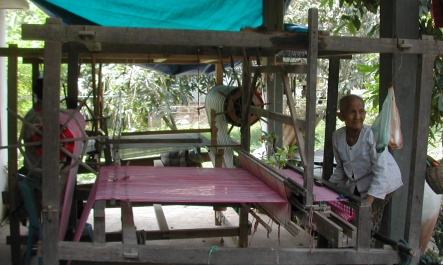
All women – young & old – weave in Chong Ko
We then made a fun stop at Peam Chi Kang. Here we visited a monastery and an elementary school.
The monastery was unremarkable other than its simplicity and its unusual painting. The walkway leading to the monastery is lined on both sides with life-size human figures, and they are painted with bright and sharply contrasting colors. But a few of the young monks were out painting on them when we arrived, so they must like that paint – or maybe it is all they have.
The school was delightful. The children were squealing with excitement when we arrived. Their classes ended while we were still in the village, and they swarmed us. They followed us back to the boat, and as we re-boarded the boat, they were hanging on the outer rails giggling and waving. They were very pleasant children.
We also saw their racing canoe, but we could not find out how long it was. It must have been at least 100 feet long. It, too, was painted brightly.
And Peam Chi Kang was another horse-and-cart village. There is something charming in this simplicity.
We went a bit further upstream and anchored at Kampong Cham. We disembarked at Kampong Cham and drove about 5 miles to the twin holy mountains of Phnom Pros (Man Hill) and Phnom Srey (Woman Hill). We actually went to Phnom Pros which is lower and more accessible than Phnom Srey. Local folklore includes a pseudo-Oedipal story to explain how stupid men were manipulated by devious women, and the result was Phnom Srey being taller than Phnom Pros. The story doesn’t warrant repeating here.
Atop Phnom Pros we found an interesting temple – Wat Nakor. It dates back to the 11th century, and it is an unusual blend of Hinduism and Buddhism with some unique symbolism. We also found some rather cheeky monkeys up there. Reportedly they have bitten many visitors, so we kept our distance.
The view across to Phnom Srey was spectacular. It looked like it would be very difficult to climb up to it, and we were glad to be on the lesser of the hills.
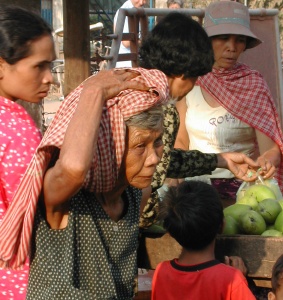
Woman in market in Angkor Ban
When we left Phnom Pros we went to the ecotourism village of Choeungkok supported by the French-Cambodian NGO Amica. Our limited understandings of the goals of AMICA include teaching the villagers how to make and market products that can be sold to tourists. That income supports education and sanitation projects. We saw evidence of those projects while we were there. We saw and purchased some woven kramas, we watched them make fans and palm sugar, and we saw water supply projects in place. We have been to AMICA’s website since returning hoping to learn more about the project, but it is only in French, and neither of us can read it. We also stumbled across a colorful wedding party underway while there. It was interesting to see.
Our final stop in Kampong Cham was the orphanage. The Pandaw Company has a few ‘Pro-Bono’ projects to which it donates, and it encourages its guests to do so. Again, our American cynicism led us to expect underfed and/or diseased begging children, and we found quite the opposite. This was a group of healthy and happy children that appear to be doing very well. Many of them have been able to develop talents, and some of their work is sold there to bring in money. We did make a donation of school supplies, and we bought a few small things. We were particularly impressed with the painting and drawing abilities of a few of the children, and we bought a beautiful watercolor that is framed and hanging up on our boat. We wish that children in all orphanages could flourish like these children appear to.
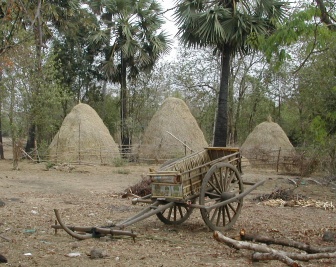
Wagon for transportation & rice husks for cooking fuel
Wat Hanchey – a beautiful temple on top of a hill – was our northernmost stop on the Mekong River. To get to it, the captain put the bow of the boat in to the shore, and the crew put out planks for the intrepid to go ashore. We say ‘intrepid’ because once ashore, there were 291 steps to the top of the hill where the temple is. It sounded much tougher than it was
Our first stop at the top of the hill was the remnants of Wat Hanchey itself. This pre-Angkor temple dates from the 7th century, and much of it is gone. However, it was worth the climb to see what remains.
We also walked around the new temple and its grounds. We walked out a ways to see a few gold Buddhas, and we saw more horse carts. No cars. Then we spent time just taking in the view. We could see for miles in both directions up and down the Mekong River. It was beautiful.
As we were heading down, a few young girls introduced themselves to us. We were impressed with their English-speaking skills, so we stopped and talked with them for a while. As we said goodbye and went on our way, one gave Nita a handful of flowers to take with her. Sometimes the simplest of gestures can mean a lot.
We had gone as far up the Mekong as we were going to go. It was time to backtrack to near Phnom Penh and head up the Tonle Sap River toward Siem Reap.
Our next stop would be at Kompong Chhnang – 124 miles away – so we had a lot of travel time ahead of us. However, this part of the Tonle Sap is known for being especially scenic, so we looked forward to it.
We were not disappointed. The river was often narrow and sometimes winding, but it was always scenic. We saw mile after mile of rural Cambodian villages. Most of the people along the river waved, and seemingly all of the children squealed with excitement as we went by. We would have liked to stop at any of the villages we were passing by, but we had a schedule to keep, and we motored on.

Children at the Choeungkok orphanage
Kompong Chhnang, on the southernmost edge of Tonle Sap Lake, has a large floating community that is mostly Vietnamese. It also has a large clay pot industry and lush green rice fields; however, we had limited time to visit here, and we saw only the waterfront.
We got on a small boat that enabled us to travel along the waterfront and the floating village. We saw big houses and small houses. Some were well kept, and others appeared derelict. We saw a variety of businesses including two machine shops. In short – a real community.
We went ashore and walked around the local market. It was late in the day when we got there, and many vendors had already left.
We really didn’t have enough time ashore to ‘get a feel’ for Kompong Chhnang. We completely missed their clay pot industry and their farms. And the people in Kompong Chhnang are known for their friendliness. But we just didn’t have enough time. If we ever return to Cambodia…
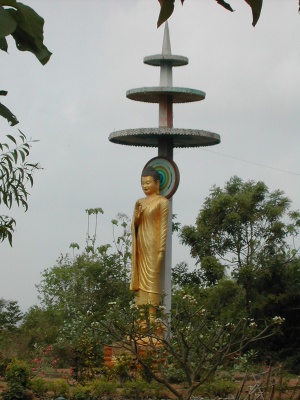
Gold Buddah off in the distance
The reason we had so little time in Kompong Chhnang is because we had to return all the way to Phnom Penh. At this time of year – nearing the end of the dry season – Tonle Sap Lake is dry in parts and too shallow for the RV Mekong Pandaw to pass. So we had to take her back to Phnom Penh to disembark then travel by road up to Siem Reap off the northeast corner of the lake. Life would have been simpler if we could have disembarked in Kompong Chhnang (it would have saved us 60 miles south by water then another 60 miles north by land), and we don’t know why we could not. But we headed back to Phnom Penh to disembark the next morning.
We had enjoyed a remarkable journey on the RV Mekong Pandaw, and it was with a bit of sadness that we said ‘goodbye’. However, we knew that we were about to enter the world of the Angkor temples, and we would not mope about for long.
Follow us to Siem Reap to visit the temples of Angkor.